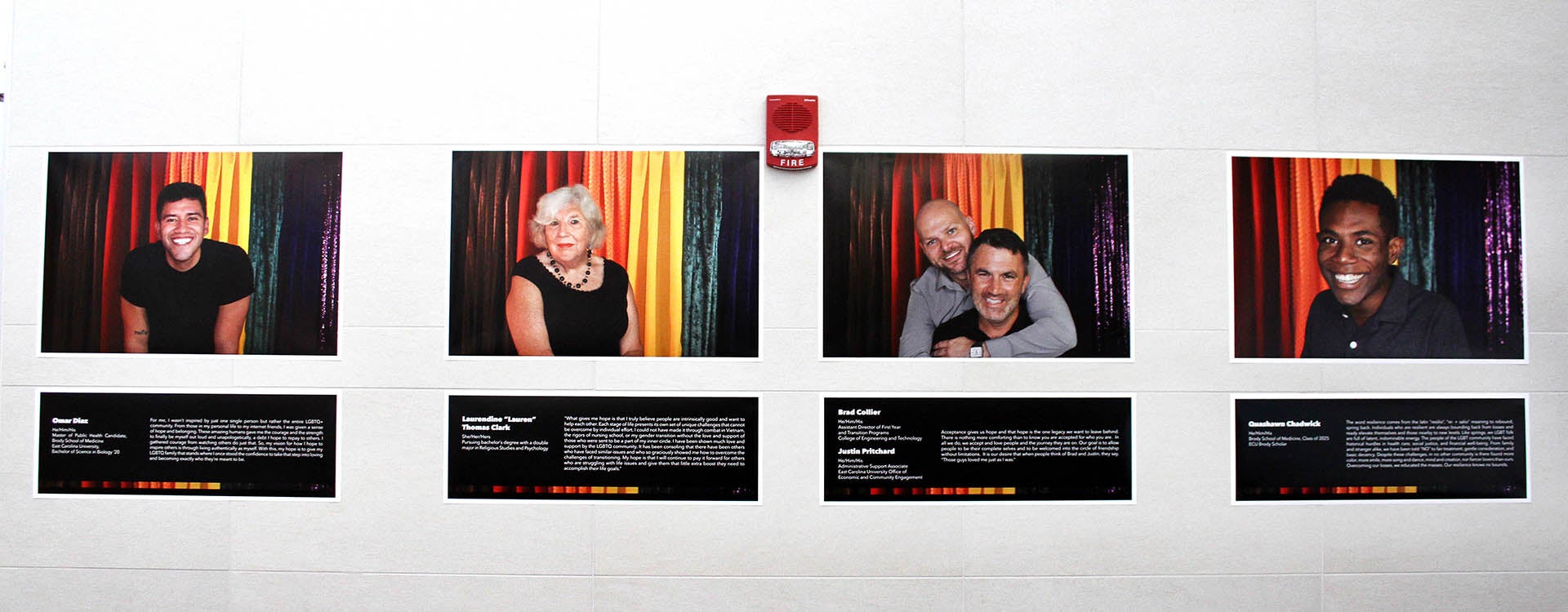True Colors exhibit features ECU’s LGBTQ+ community
On the surface, it’s just a photograph. However, Quashawn Chadwick believes it speaks with a loud voice.

ECU medical student Quashawn Chadwick is one of the students featured in the True Colors photography exhibit that will be up through the end of October on the second floord of the Main Campus Student Center in honor of LGBT History Month. (Photos by Ken Buday)
Chadwick is one of nearly 20 students at East Carolina University to be featured in the True Colors photography exhibit inside the Main Campus Student Center.
The Dr. Jesse R. Peel LGBTQ Center partnered with Angela Wells and the School of Art and Design for the exhibit, which will be up through the end of October as part of international LBGT History Month. The photographs were unveiled during an opening reception Monday.
“It will mean I showed up to speak when I had the chance,” Chadwick said of seeing his picture hanging outside of the second-floor ballrooms. “I hope to always stand up and speak up for what I believe.”
The theme for this year’s exhibit focuses on legacy and vision as it marks the center’s 10th anniversary. Each photo in the exhibit is accompanied by a short essay from the person pictured.
“We wanted to talk to people in the show about who has influenced them, what their vision is for the future and what they hope their legacy will be,” said Mark Rasdorf, senior associate director of intercultural affairs at ECU and the center’s director.
As a first-year medical student at the Brody School of Medicine, Chadwick said he does not have a lot of free time to be involved in social movements but believes being a part of the exhibit is a way for him to represent the community and have his voice heard.
“As a gay man, contributing to the discourse regarding LGBTQIA+ representation, equality, health, justice, etc., is a cause that I feel strongly about,” said Chadwick, who is from the town of Albemarle, about an hour east of Charlotte. “I think unity and diversity of perspective is key when trying to enact social change.”
As for the theme of the show, Chadwick believes in the legacy of resiliency that is part of the LGBTQ+ community.
“It’s really a message that hits close to home for me,” he said.
Chadwick said the exhibit provides him a platform to share his thoughts.
“I think representation matters,” Chadwick said. “I think that thinkers, artists, creatives of all types and researchers who feel called to speak up about what matters to them should do so, especially when what matters is the fair treatment and longevity of people. I believe that it contributes to the zeitgeist, the culture at large, and only then can incremental change take place. I think the process of changing people’s hearts to consider others passionately — toward whom they might not have felt positively in the past — is a slow but important work.”
The exhibit is in its fifth year. It did not take place last year because of the pandemic. It started in 2016 after Wells met Rasdorf as he conducted Safe Zone Training. They struck up a conversation about a traveling photo exhibit on trans identities that featured people from the Northeast.
“I was talking to Angela, and she said, ‘We can do one here. We can just make our own exhibit,’ and that’s how it started,” Rasdorf said, adding that student photographers gain valuable experience by taking the pictures and creating the works that are displayed.
Each year of the show has carried a different theme. Rasdorf said the idea of this year’s theme was not only to mark 10 years of the center, but also to highlight the grit and tenacity of the LGBTQ+ community that has helped establish a legacy of perseverance and hope.
That theme struck Omar Diaz, a public health graduate student from Asheville who is part of the exhibit.
“For me, I wasn’t inspired by one single person but rather the entire LGBTQ+ community,” Diaz said. “From those in my personal life to my internet friends, I was given a sense of hope and belonging. These amazing humans gave me the courage and strength to finally be myself out loud and unapologetically, a debt I hope to repay to others. I gathered courage from watching others do just that. So my vision for how I hope to inspire others is through living authentically as myself. With this, my hope is to give my LGBTQ+ family that stands where I once stood the confidence to take that step into loving and becoming exactly who they’re meant to be.”
Diaz said that having the exhibit in such a popular location on campus gives it more meaning.
“I think this exhibit is important in the sense that it allows visibility of the LGBTQ+ community at ECU, and it allows individuals who may not be in a place to truly be who they are yet a sense of hope to one day be exactly who they want to be,” Diaz said. “Hopefully, this helps someone — even just a single person — to think, ‘If they can do it, so can I.’ I think that is my favorite part of being a part of this year’s True Colors exhibit.”

These are some of the photographs that make up the True Colors exhibit.